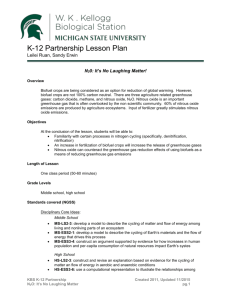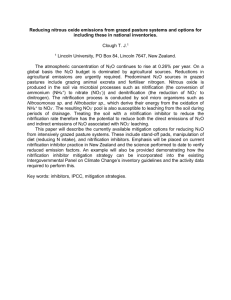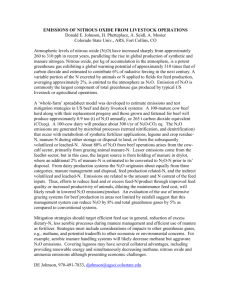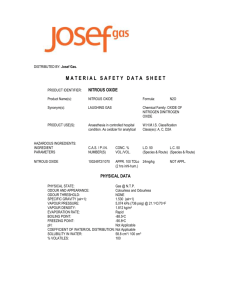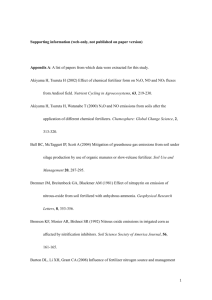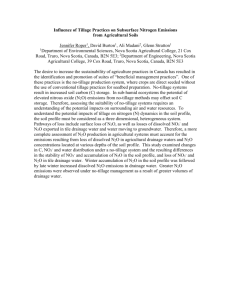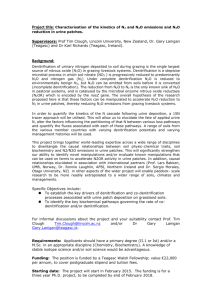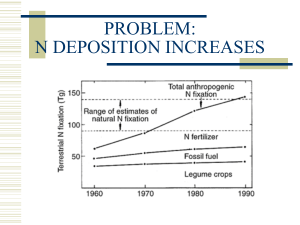Standards Addressed
advertisement
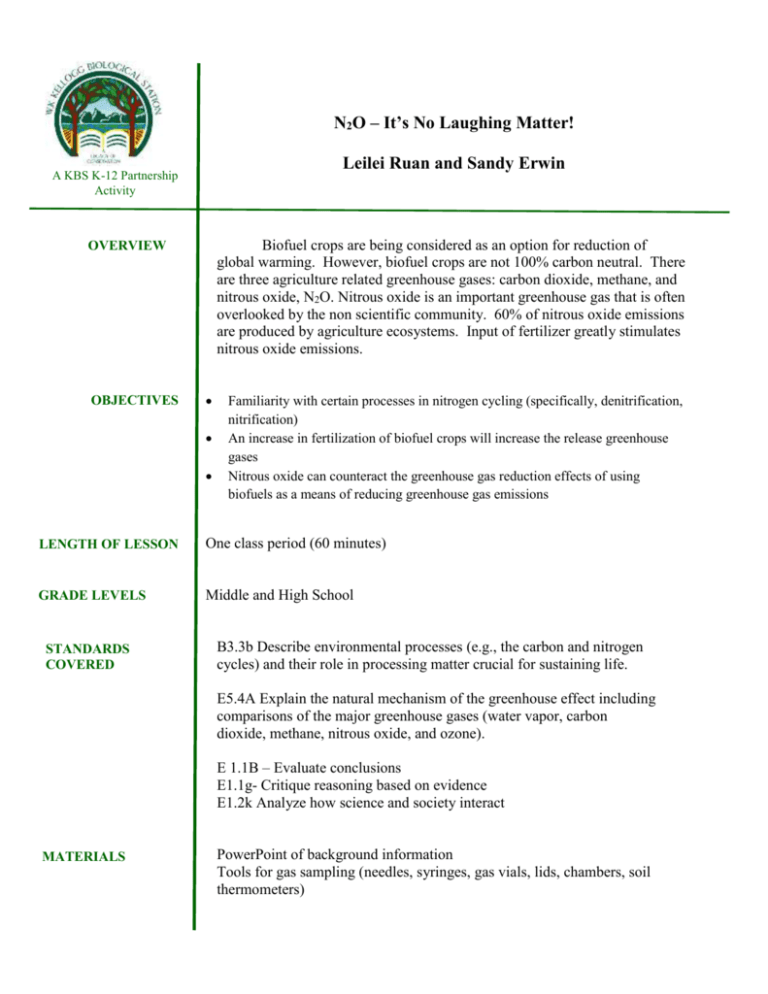
N2O – It’s No Laughing Matter! Leilei Ruan and Sandy Erwin A KBS K-12 Partnership Activity Biofuel crops are being considered as an option for reduction of global warming. However, biofuel crops are not 100% carbon neutral. There are three agriculture related greenhouse gases: carbon dioxide, methane, and nitrous oxide, N2O. Nitrous oxide is an important greenhouse gas that is often overlooked by the non scientific community. 60% of nitrous oxide emissions are produced by agriculture ecosystems. Input of fertilizer greatly stimulates nitrous oxide emissions. OVERVIEW OBJECTIVES Familiarity with certain processes in nitrogen cycling (specifically, denitrification, nitrification) An increase in fertilization of biofuel crops will increase the release greenhouse gases Nitrous oxide can counteract the greenhouse gas reduction effects of using biofuels as a means of reducing greenhouse gas emissions LENGTH OF LESSON One class period (60 minutes) GRADE LEVELS Middle and High School STANDARDS COVERED B3.3b Describe environmental processes (e.g., the carbon and nitrogen cycles) and their role in processing matter crucial for sustaining life. E5.4A Explain the natural mechanism of the greenhouse effect including comparisons of the major greenhouse gases (water vapor, carbon dioxide, methane, nitrous oxide, and ozone). E 1.1B – Evaluate conclusions E1.1g- Critique reasoning based on evidence E1.2k Analyze how science and society interact MATERIALS PowerPoint of background information Tools for gas sampling (needles, syringes, gas vials, lids, chambers, soil thermometers) Vernier carbon dioxide probes for measuring soil CO2 emissions, 1 Laptop computer with Logger Pro 3 software, four 250-mL respiration chambers BACKGROUND The IPCC (Intergovernmental Panel on Climate Change) reported that global mean surface temperatures have increased 0.74 oC (0.56 to 0.92 oC) from 1906 to 2005 and predicted temperature rises of 1.1- 6.4 oC by 2100. The reason is largely attributed to the increase in the greenhouse gases carbon dioxide (CO2), methane (CH4) and nitrous oxide (N2O). For example, concentration of CO2 in the atmosphere has increased from 280 ppm in 1750 to 379 ppm in 2005, CH4 has increased from 715 ppb to 1732 ppb and N2O has increased from 270 ppb to 319 ppb (IPCC, 2007a). Although the concentration of N2O is much smaller than of CO2, it is 298 times more potent than carbon dioxide in its ability to affect climate change. N2O is from anthropogenic source (cultivated soils, animal waste, biomass burning and industry) and natural source (soil under natural vegetation and ocean). Of the anthropogenic sources of N2O emissions, agricultural soil emissions account for about 60%. In soil, nitrous oxide is mainly produced by two microbial processes: denitrification and nitrification. Denitrification occurs under anaerobic conditions when soil NO3- is reduced to NO, N2O and finally to N2 by anaerobic denitrifiers. Nitrification occurs in aerobic conditions when soil NH4+ is oxidized to NO2- (nitrite) and then to NO3-. Intermediary compounds formed during nitrification can decompose to gaseous N2O. Biofuels produced from agricultural feed stocks (e.g.,crop residues, dung, and potentially grown energy crops) is one option for reducing GHG emissions by substituting contemporary biomass carbon for fossil fuels. Biofuels are carbon based energy sources in which plants capture solar energy and then their biomass is burned for fuel either directly or following transformation into liquid form. Biofuel crops need nitrogen fertilizer for their growth, which enhance soil N2O emissions due to more available NH4+ and NO3- for nitrification and denitrification. Some scientists suggested that there may be no GHG mitigation using biofuels when large fertilization induced soil N2O emissions are properly considered in the full life cycle assessment during corn ethanol production. In order to appropriately evaluate the contribution of biofuels to climate change, N2O emissions need to be monitored and quantified after fertilization. ACTIVITIES OF THE SESSION RESOURCES Presenting the introduction in the PowerPoint Showing CO2 emissions from different sources using carbon dioxide sensor Visiting field sites to learn how to collect nitrous oxide from soils Data analysis: Students should explain how their results differed between 2009 and 2010. Why do they think these differences occurred? http://school.discoveryeducation.com/schooladventures/soil/soil_safari.html The “Earthship” takes you on an underground journey that lets you get to know the soil community at various scales. http://school.discoveryeducation.com/schooladventures/soil/teacher_tips.html Teachers guide to accompany soil safari interactive game and offers additional ideas for teaching soil science.
